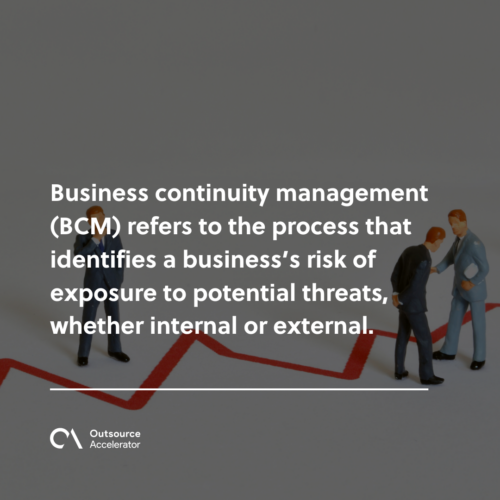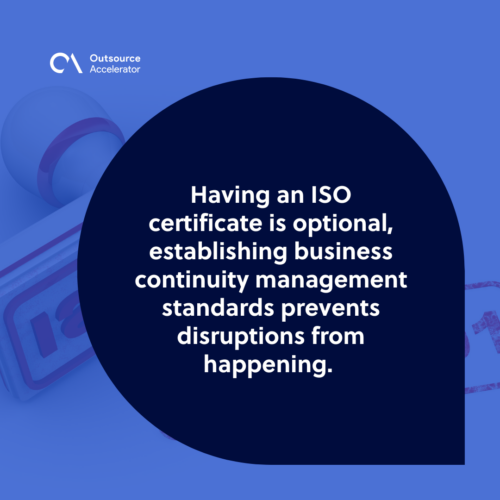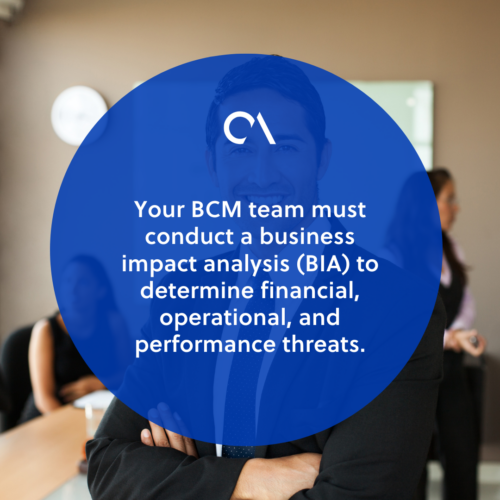The ultimate guide to business continuity management

The COVID pandemic brought major uncertainty and disruptions to businesses across the world. Aside from forcing innovation, it taught us the importance of having a backup plan in times of crisis – a business continuity management strategy, if you will.
A recent study from Yelp shows that 60% of business closures during COVID are now permanent. Small businesses are among the companies that are hit the hardest, prompting their closures due to bankruptcy and lack of continuity plan.
As a part of being future-proof, enterprises of all sizes are now highly encouraged to have their business continuity plans at hand. With proper business continuity management, they get to stand these challenges that could occur in the future.
Defining business continuity management
Business continuity management (BCM) refers to the process that identifies a business’s risk of exposure to potential threats, whether internal or external.
Disruptions such as data breaches, natural disasters, financial crises, and pandemics could happen at any time. This makes companies vulnerable to lose their data, assets, or even their entire business if not prevented.
BCM helps an institution identify possible threats it could encounter and create plans for prevention and recovery. Once done effectively, companies can assure that their cure functions, compliance obligations, and investors’ expectations are safeguarded.

Main areas of business continuity management
In some cases, business continuity management is considered a part of enterprise risk management. However, compared to their larger counterparts, companies implementing BCM only use this in a worst-case scenario.
There are three major areas tapped by BCM. These are:
- Planning and prevention
- Disaster response
- Return to normal
ISO 22301 and business continuity
ISO 22301, or the International Standard for Business Continuity Management, highlights the importance of BCM to businesses of all sizes and industries. It provides a framework for setting up a BCM system depending on the risks a company is prone to.
The majority of companies worldwide are not required to acquire this certificate. Though, it is essential to those required to engage in contingency planning. This includes utilities, transport, healthcare, and other essential public services.
In 2020, the International Organization for Standardization (ISO) saw a huge increase (82.9%) in companies and institutions getting the ISO 22301 certification worldwide.
Is establishing business continuity management standards necessary?
Having an ISO certificate is optional, establishing business continuity management standards prevents disruptions from happening.
Conducting business impact analysis helps companies identify critical business processes, prioritize activities, and develop strategies to mitigate risks.
By setting standards, companies protect business operations, enhance resilience, and reduce unexpected event impact.
Aside from this, several other reasons make BCM necessary for a business.
Preserve company’s reputation
Customers and employees will laud a company’s efforts to respond and act quickly during a major situation.
Boost morale
Their efforts will ease their employees’ worries and uncertainties about their future in the company. This could even boost their morale and motivation.
Build stronger connections
An effective BCMS shows that a company runs well from the top to its employees. This tells your partners and subsidiaries that you take care of your customers, employees, and partners responsibly.
Meet regulatory requirements
BCM is required by governance regulations to effectively implement continuity arrangements. With this, you are obliged to be aware of several risks such as cyber threats and act accordingly in case it happens.

By safeguarding critical business functions, organizations can ensure seamless operations despite unexpected disruptions.
Effective business continuity planning serves as a foundational element in meeting regulatory demands while enhancing the overall resilience and sustainability of the business.
Phases of business continuity management framework
The business continuity management framework has six phases:
Programming the management
The BCM to be made should have the top management’s nod since it is crucial. This is why it’s best to program first the executives of a company.
Understanding the organization
Everyone has to be on board with the BCM policy, including the stakeholders, subsidiaries, and outsourcing suppliers. Reach out to the internal teams, stakeholders, and suppliers of the company and communicate the agreed policy.
Identifying BCM strategy
First, determine a BCM sponsor who can implement business continuity management according to the policy. The sponsor will then form a team that can formulate the entire strategy.
A sponsor won’t always necessarily come from an internal department. A subsidiary or outsourcing partner can also qualify for this role
Developing/implementing BCM response
The team will then carry out a risk assessment for critical functions and look for alternate response strategies according to the results. This is followed by creating business recovery and disaster recovery plans.
Practicing the response
Once implemented, the BCM team will create an exercise program covering different plans in line with their objectives and identified limitations. They will then update the plans based on these limitations.
Reviewing and embedding BCM
Lastly, the best way to review and improve BCM strategies is by using the plan-do-check-act cycle. Here, the company continuously tests its implemented strategies and carries out preventive actions in case anything goes wrong with it.
What is a business continuity plan (BCP)?
A part of a risk management strategy, a business continuity plan (BCP) is an outlined structure of a company’s risk and resiliency plan. It lists down the potential threats a business may face such as cyberattacks and identifies the ways to prevent them.
A concrete BCP is crucial to business continuity management. It takes into writing the ways on how they can assure continuity amidst a crisis.
BCP vs Disaster recovery (DR) plan
Some companies would think a disaster recovery (DR) plan is the same as a business continuity plan. However, a BCP provides a more comprehensive approach to dealing with disruptions and laying out contingencies.
While BCPs focus on keeping the shop open, disaster recovery plans tend more on getting back to normal as soon as possible.
A disaster recovery plan is more focused on restoring affected business “as usual” aspects such as data access and IT infrastructure. Not only that, it even adds recovery strategies to strengthen employee safety measures.
These involve having fire and earthquake drills, purchasing emergency supplies, and even teaching first aid for responders.
Steps in making a business continuity plan
A BCP usually includes the following sections:
- Objectives
- Risk management plan and analysis
- Incident response plan, response team, and communications list
- Recovery plan, and
- Review and update schedule
As iterated earlier, a serious business continuity management framework can help you craft your BCP easier. With that, here are some steps in creating a BCP.
Assemble your BCM team
Your BCM team should be capable and authorized to handle your continuity plans based on your objectives.
Gather them and create a list of the key people including their full names, titles, and contact information. At the same time, prepare a process for updating your plans and how they will reach the BCM team.
Put employees’ safety first
Always prioritize the well-being of your employees first. Create a safe working environment as early as now by establishing wellbeing programs and proper lines of communication in case of emergencies.
Conduct an impact analysis
Your BCM team must conduct a business impact analysis (BIA) to determine financial, operational, and performance threats.
You can use your risk assessment analysis made in creating your BCM framework as a guide in calculating the risks’ impact.

Implement your recovery strategies
Make sure you can implement your BCP and recovery strategies once a calamity happens. Discuss your BCP with the entire company and already practice your strategies as possible.
Continuously make improvements
Lastly, you can use the plan-do-check-act (PDCA) method similar to your BCM framework when improving your BCPs. sit down with your BCM team periodically to see what you can improve to your plans and make sure everything will flow smoothly.
Business continuity management for global businesses
The pandemic proved that threats and calamities can strike anytime. The last thing a company can do to protect its business is to not have a business continuity management framework implemented.
It’s not too late to be resilient and prepare for another calamity ahead. This is why companies are encouraged to have continuity measures as soon as possible.
At the same time, continuity planning is not necessarily and exclusively done with a pure in-house department nowadays. These days, businesses rely on their outsourcing suppliers as a way to ensure that they continuously serve their customers.
Compliance with standards set by regulatory authorities, such as the Financial Industry Regulatory Authority (FINRA), is crucial to ensure seamless operations amidst unforeseen disruptions.
Having a business continuity management framework in place not only protects companies. It even protects its resources, employees, and credibility.
Implementing business continuity plans is essential for mitigating risks and preparing for potential disasters.







 Independent
Independent




